業界初、機械式駐車設備における自動運転自動車の駐車実証実験に成功
2019年07月01日
新明和工業株式会社(本社:兵庫県宝塚市、取締役社長:五十川 龍之、以下:新明和工業)と国立大学法人群馬大学(学長:平塚 浩士、以下:群馬大学)は、この度、群馬大学の「次世代モビリティ社会実装研究センター」(センター長:太田 直哉、以下:CRANTS)内に設置した検証用機械式駐車設備において業界で初めて、自動運転自動車 ※1(以下、自動運転車)の駐車実証実験に成功しました。
- ※1群馬大学が所有する実験用の車両
機械式駐車設備における自動運転車の駐車実証実験 [再生時間:2分15秒]
1. 本研究における成果
■自動運転車と機械式駐車設備の協調により、安全かつ高精度な自動入庫を実現
今回の実証実験では、共同開発した「APPS(Advanced Pilot Parking System)」を導入し、業界で初めて「V2P」すなわち自動運転車(V)と機械式駐車設備(P)の間を通信により繋ぐことで、自動運転車とインフラである駐車設備が協調して駐車スペースに安全かつ高精度に自動運転車を誘導することに成功し、平面駐車と比べて高度な運転技術が求められる機械式駐車設備への自動入庫を可能にしました。
(1) 駐車フロー
自動運転車と機械式駐車設備が協調し、安全かつ高精度な自動入庫を実現
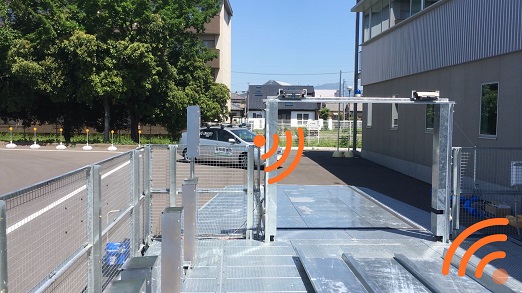
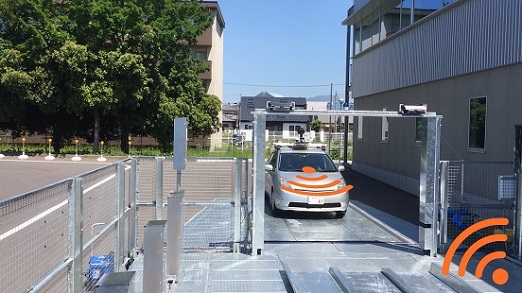
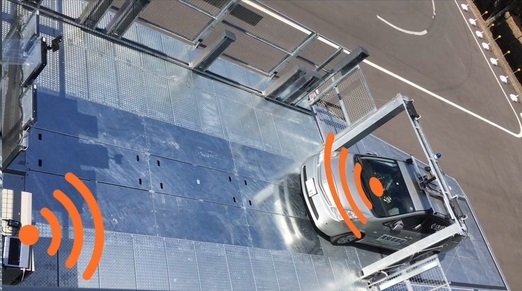
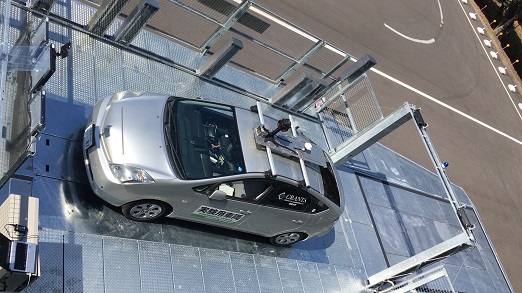
⑤ 「③」「④」をくり返すフィードバック制御により駐車完了
実際の駐車位置と、位置情報とのズレ幅が、目標値の±10㎜以内を実現!
(2) 「APPS(Advanced Pilot Parking System)」の特長
「V2P」の確立により、安全で高精度な自動駐車を実現
① 業界初となる、自動車と機械式駐車設備間の通信プロトコルを開発
- 今般開発した通信プロトコルにより、自動車と機械式駐車設備の双方向通信が可能となり、機械式駐車設備側が自動運転車を駐車位置まで的確に誘導
② レーザースキャナ(LiDAR)を応用した車両位置特定アルゴリズムを開発
- レーザスキャナから得られる点群データから車両位置を10㎜単位で認識し、自動運転車を安全かつ正確に駐車位置まで誘導
③ 手動運転車と自動運転車の混在走行環境にも適応
- 完全自動運転車が普及するまでの過渡期において、手動運転と自動運転いずれにも対応
■駐車場内での事故発生防止
機械式駐車設備において、安全対策(センサー設置等)は各製造元において実施されているものの、入庫や出庫時に「人」が行う操作ミスによる事故の根絶が難しい状況にあります。また、自動車事故の約27%が、平面や自走式の立体駐車場も含めた駐車場内で発生しているという調査結果もでています。※2
今般、自動運転車を安全かつ高精度に機械式駐車設備まで誘導し、駐車させる技術を確立したことで、無人状態での駐車が可能となり、運転者をはじめとする「人」に依存した操作が不要となるため、駐車場における人身事故発生リスクは限りなくゼロへ近づけることが可能となります。
- ※2出典:一般社団法人 日本損害保険協会東北支部「東北6県の車両事故実態に関するモニタリング調査」(2017年1月~12月)
2. 共同研究の概要
完全自動運転社会の実現に向けて、自動運転車の公道実証実験を行うなど、次世代モビリティシステムの社会実装に向けた研究に積極的に取り組む群馬大学と、未来社会における機械式駐車設備の進化を目指す新明和工業が、2017年12月から自動運転車の受け入れに関する駐車設備の共同研究に着手しました。
今回の実証実験の成功は、開発の第1フェーズの目標としていた、CRANTS敷地内の道路を走行する自動運転車と、検証用に設けたエレベータ方式駐車設備との通信システムの開発成功を意味し、業界で初めて自動入庫を実現しました。
自動運転技術は、世界の自動車メーカー各社が取り組んでいるものの、インフラ側との連携は進んでおらず、現状の自動駐車機能の精度では、機械式駐車設備への駐車が困難とされていました。一方で、国内の機械式駐車設備は、都市部を中心に累計約57万基(310万台分)が設置されており、自動運転車が台頭する世の中にあっても機械式駐車設備の有効利用は必須課題であることから、今般の実験の成功は、機械式駐車設備の価値向上を意味しております(図1)。
今後、新明和工業と群馬大学は、他のタイプの機械式駐車設備においても駐車実証実験を行い、その後、新明和工業の研究拠点(兵庫県宝塚市)に場所を移して、APPSと車路管制システムを組み合わせた実証実験に移行する予定です。これらの検証データを基に、社会実装の具体化に取り組んでまいります。
併せて、自動車関連企業や不動産デベロッパーなど、「人と社会環境」、「車」、「駐車場」に関連する各種業種・産業や自治体にも働きかけ、自動運転車の普及と並行して周辺環境を整える「街づくり」を志向し、世界に先駆けた完全自動運転社会の実現に貢献してまいります。
【共同研究内容(概略)】
自動運転車の機械式駐車設備利用実現に向けた研究
- 1市販の自動駐車機能による機械式駐車設備への駐車確認実験、ならびにさまざまな機械式駐車設備に自動駐車するための研究および技術開発
- 2駐車敷地内における、自動運転車への走行誘導、ガイダンスの実証実験と車路管制システム構築
- 3自動車と車路管制システム・機械式駐車設備の通信技術構築
- 4車路、駐車設備内の高精度人検知システムの構築
- 5上記自動運転車と自動運転車に対応した機械式駐車設備による実証実験
- 6完全自動運転車専用駐車設備、手動運転車・自動運転車混載に対応する駐車設備の構想提案
3. 今後のスケジュール(2019年7月1日時点)
- 共同研究期間
-
- CRANTSでの実証実験期間:2017年12月~2020年3月
- 新明和工業株式会社 宝塚工場内での実証実験期間: 2020年4月~2020年9月
ご参考:機械式駐車設備が自動運転車に対応するメリット
~ より「便利」「快適」かつ「安全」に ~
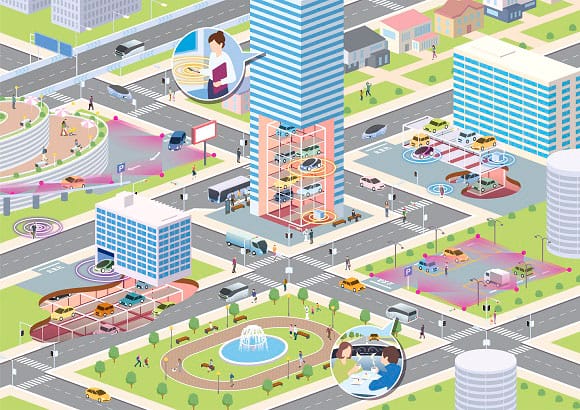
【マンションの機械式駐車設備でもホテルのようなバレーサービスを日常に】
(1)出かけたい時に、「クルマ」が、「ヒト」を迎えに来る時代へ
- 1外出前に、スマートフォン等から車の出庫を予約
- 2時間になると、機械式駐車設備から自動出庫
- 3車と機械式駐車設備とが通信し、出庫した車が自動運転で予約した時間にエントランスに到着
(2) 帰宅後、車は自動運転で駐車場へ
- 1エントランスで降車
- 2車は、自動運転で機械式駐車設備へ走行
- 3車と通信した機械式駐車設備が自動で入庫対応し、駐車が完了
(3) 利便性・安全性が飛躍的に向上
- 1「車」と「機械式駐車設備」が連携することによって、自動で入出庫が可能となり、これまで煩わしいとされてきた「駐車動作」から解放され、「駐車」に対する既成概念を払しょく
- 2機械式駐車設備内に人が立ち入る必要がなくなるため、設備内での事故発生リスク低減、および現状よりコンパクトな設備開発が可能に
本件に関するお問い合わせ先
新明和工業株式会社
経営企画本部 広報・IR部
国立大学法人群馬大学
研究推進部産学連携推進課 荒牧センター事務室 担当:石坂
027-220-7443(直通)
以上
このコンテンツに掲載している内容は、発表日現在の情報です。
これらの情報は、当社グループの事業戦略および組織の変更などにより、最新の情報と異なる場合がありますのでご了承ください。
